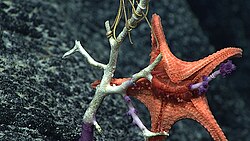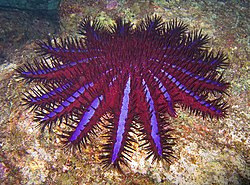Starfish
Starfish, or sea stars, are Echinoderms of the Class Asteroidea.[3]p35
| Starfish | |
|---|---|

| |
| Fromia monilis | |
| Scientific classification | |
| Unrecognized taxon (fix): | Asteroidea |
| Child taxa and orders | |
| |
All live in the ocean, on the sea floor. Many starfish live in deep water, others in shallow water. Some live in the intertidal zone, between low and high tide.[4] They have five or more arms and can be quite large. The Sunflower sea star (Pycnopodia helianthoides) is the largest: fully grown, its arm-span is about a metre. This is a bit larger than the famous Crown-of-thorns starfish, which lives on coral polyps.
Although starfish are invertebrates, they do have a kind of skeleton. The bodies of starfish are composed of calcium carbonate plates, known as 'ossicles'. These form the endoskeleton, which takes on a variety of forms such as spines and granules.
They have a primitive nervous system, but not a brain. They also do not have blood, instead they use sea water to pump things around their bodies.
There are over 1500 different species of sea star. Most sea stars are predators. They eat mussels, clams, and other bivalves. Occasionally, they catch small fish.[5][3]
Symmetry
Most starfish have five arms, called rays that come out from a center circle (disk). If a starfish has more than five rays, it will often have rays in multiples of five; there could be 10, 15, 20, or even 30 rays on one starfish. This is called pentameral (five-fold) symmetry.
Skeleton
The degree of protection offered by the skeleton differs between species. If the skeleton becomes more rigid, it offers better protection against predators. However, this will tend to limit its feeding alternatives. Great flexibility is required for the process of external digestion used by many species to eat bivalves. The less well armoured species may adopt a life in places where they are not so open to predation. The heavily armoured ones can tough it out in the most competitive habitats:
- "A heavily calcified sturdy skeleton capable of resisting both large and small predators has evolved in many tropical sea stars... a very firm body wall... still permits a degree of flexibility of the body and arms".[6]
Feeding

Senses
The movement of starfish is guided by their senses of touch and sight. There are five 'eyes', light-sensitive cushions, one at the end of each arm. These and the tube feet are connected to nerve fibres, so these animals are more complex than might appear.
Tube feet
Although starfish started off as filter-feeders, they evolved to become major predators of shell-fish (the brachiopods and bivalves). They can also eat small crustacea and fish. Their tube feet developed suckers, perhaps originally to improve movement. Later, they were used to open shell-fish.
- "Suckered tube feet may not have been present in any Palaeozoic sea star".[7]
Feeding methods
The shells of brachiopods and bivalves are held together by strong muscles. What the starfish does is clamp hold of them on either side with its tube feet, and apply a steady pull. The starfish, with its muscles and hydraulic system, can pull for much longer than any bivalve muscle can withstand. Apparently, ten minutes are usually enough to open the shell a bit. Then the starfish slips its stomach inside the shell. The stomach can get through a slot as narrow as 0.1mm.[8] The starfish then dissolves the mollusc where it lives, absorbing the nutrients. This digestion process takes much longer than opening the shell, perhaps a couple of days.[9]
Some species swallow the shell whole, and dissolve the contents inside their stomach, then push out the shell afterwards.[10][3]p45
The ability of starfish to eat brachipods and bivalves developed in the Mesozoic, especially in the Jurassic and Cretaceous. This was part of the Mesozoic marine revolution, which transformed the sea-floor fauna. Weakly defended and static shellfish disappeared, and more heavily armoured or more mobile shellfish flourished.[11][12][13]
Regeneration
Starfish, like many sea creatures, are able to regenerate (grow back) parts of their bodies. Starfish are better at regeneration than most other creatures. Not only can a new ray grow when a ray is torn off, but if the torn off ray has even a small piece of the central disk still attached, a whole new starfish can grow from the one ray.[3]p35
Because starfish like to eat clams and oysters, fishermen who gather shellfish have tried for years to get rid of them. To kill the starfish, fishermen would catch them, slice them right in half, and throw them back in the ocean. However, because starfish can grow back parts of their bodies, they were actually increasing the number of starfish.
Starfish Media
Three kinds of bilaterally symmetric starfish larvae (from left to right) scaphularia larva, bipinnaria larva, brachiolaria larva, all of Asterias sp. Painted by Ernst Haeckel
"Comet" of Linckia guildingi, showing starfish body regrowing from a single arm
Sunflower seastar regenerating missing arms
A Circeaster pullus starfish everting its stomach to feed on coral
Pisaster ochraceus consuming a mussel in central California
American herring gull feeding on a starfish
Starfish fossil, Riedaster reicheli, from the Plattenkalk Upper Jurassic limestone, Solnhofen
Video showing the tube feet movement of a starfish
References
- ↑ Sweet, Elizabeth (22 November 2005). "Fossil Groups: Modern forms: Asteroids: Extant Orders of the Asteroidea". University of Bristol. Archived from the original on 2007-07-14. Retrieved 2016-05-31.
- ↑ Knott, Emily (7 October 2004). "Asteroidea. Sea stars and starfishes". Tree of Life web project. Archived from the original on 2020-04-25. Retrieved 2013-05-10.
- ↑ 3.0 3.1 3.2 3.3 Nichols, David (1969). Echinoderms. Ebury Press. ISBN 978-0-09-065994-4.
- ↑ At low tide they would be in rock pools.
- ↑ Sweet, Elizabeth (2005-11-22). "Asterozoa: Fossil groups: SciComms 05-06: Earth Sciences". Archived from the original on 2007-07-14. Retrieved 2008-05-07.
- ↑ Blake D.B. 1984. Constructional morphology and life habits of the Jurassic sea star Sphaeroaster Quenstadt. Neues Jb. Geol. Palãont. Abb. 169, 74–101.
- ↑ Blake D.B. 1981. The new Jurassic sea star Eokainaster and comments on life habit and the origins of modern Asteroidea. J. Paleont. 55, 33–46.
- ↑ Vermeij G.J. 1987. Evolution and escalation: an ecological history of life. Princeton N.J. p153
- ↑ Jangoux M. and Lawrence J.M. (eds) 1982. Echinoderm nutrition. Balkema, Rotterdam.
- ↑ Nicholson F.C. How a sea star gets its clam. HighlightsKids. <http://www.highlightskids.com/Science/Stories/SS0596_howseastargetsclam.asp Archived 2010-03-15 at the Wayback Machine>.
- ↑ Vermeij G.J. (1977). "The Mesozoic marine revolution; evidence from snails, predators and grazers". Paleobiology. 3 (3): 245–258. doi:10.1017/S0094837300005352. JSTOR 2400374. S2CID 54742050. Retrieved 2008-05-13.
- ↑ Stanley, S.M. (2008). "Predation defeats competition on the seafloor". Paleobiology. 34: 1–21. doi:10.1666/07026.1. S2CID 83713101.
- ↑ Stanley SM (1974). "What has happened to the articulate brachiopods?". GSA Abstracts with Programs. 8: 966–967.
Other websites
| Wikispecies has information on: Asteroidea. |
| Wikimedia Commons has media related to Lua error in Module:Commons_link at line 62: attempt to index field 'wikibase' (a nil value).. |
- Jan Parmentier: Growth of a starfish: the development of the larva of an echinoderm. Micscape Microscopy and Microscope Magazine
- BBC [1] Archived 2010-09-12 at the Wayback Machine
- from the Tree of Life project Archived 2010-05-01 at the Wayback Machine
- Classification of the Extant Echinodermata Archived 2006-07-09 at the Wayback Machine









